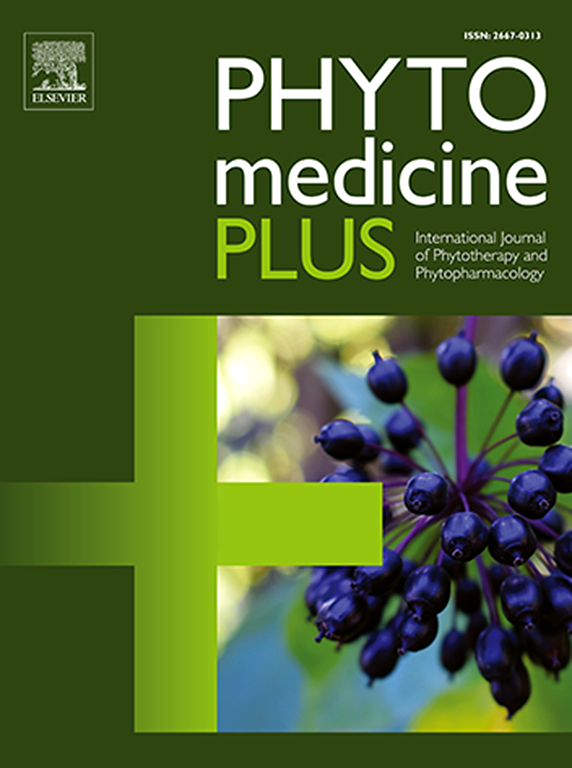肉苁蓉根、叶和种子还原性和碳水化合物酶抑制活性的比较
Q3 Pharmacology, Toxicology and Pharmaceutics
引用次数: 0
摘要
苦参的民族医学用途部分是由于它的抗糖尿病特性。目的比较硝酸菌根、叶和种子的抗氧化能力和总还原能力,以及碳水化合物水解酶的抑制潜力。方法采用标准的实验方法,考察硝酸菌的抗氧化还原能力和对碳水化合物水解酶的抑制作用。结果烟叶甲醇提取物的还原力最强(653.52 mgASC/g),其次是种子提取物(620.11 mgASC/g)。提取物的自由基清除能力有浓度依赖性。与根提取物(IC50 = 470.40µg/ml)和叶提取物(IC50 = 560.65µg/ml)相比,黑草籽提取物的清除率最高(IC50 = 190.7µg/ml)。而种子提取物对ABTS自由基的清除能力(IC50 = 174.02±0.75µg/ml)高于根提取物(IC50 = 181.83±1.01µg/ml)和叶提取物(IC50 = 279.87±1.39µg/ml)。α -淀粉酶和α -葡萄糖苷酶抑制性能随浓度的增加而稳定增加,与格列本脲的抑制性能一样。其中,烟叶种子甲醇提取物的抑菌活性最高,达到95.70%,而根提取物和叶提取物的抑菌活性分别为92.39%和83.58%。硝酸菌表现出较强的还原和酶抑制特性,这是浓度依赖性的,与格列本脲比较有利。相比之下,烟叶甲醇提取物对α-淀粉酶的还原能力和抑制能力最强,而种子甲醇提取物对自由基的抑制能力和α-葡萄糖苷酶的活性最强。本文章由计算机程序翻译,如有差异,请以英文原文为准。

Comparative reducing and carbohydrate enzyme inhibitory activities of the root, leaf, and seed of Picralima nitida
Background
The ethnomedicinal uses of Picralima nitida is partly due to its antidiabetic properties.
Purpose
In this study, the antioxidant and total reducing power, as well as the carbohydrate hydrolysing enzymes’ inhibition potentials of the root, leaf, and seed of P. nitida were compared.
Methods
The antioxidant reducing power of P. nitida as well as its ability to inhibit selected enzymes of carbohydrate hydrolysis were evaluated using standard experimental methods.
Results
Methanol extract of P. nitida leaves exhibited the strongest reducing power (653.52 mgASC/g) followed by the seed extract (620.11 mgASC/g). The free radical scavenging powers of the extracts were concentration dependent. P. nitida seed extract exhibited the highest scavenging ability (IC50 = 190.7 µg/ml) as compared to the root extract (IC50 = 470.40 µg/ml) and leaf extract (IC50 = 560.65 µg/ml). However, the seed extract had the highest ABTS radical scavenging ability (IC50 = 174.02 ± 0.75 µg/ml) in comparison with the root extract (IC50 = 181.83 ± 1.01 µg/ml) and leaf extract (IC50 = 279.87 ± 1.39 µg/ml). Alpha-amylase and alpha-glucosidase inhibitory properties of the extracts increased steadily with increasing concentration, as that of glibenclamide. The methanolic extract of P. nitida seed had the highest inhibitory activity (95.70 %) as compared to that of the root (92.39 %) and leaf (83.58 %) extracts.
Conclusion
P. nitida show strong reducing as well as enzyme inhibitory properties which are concentration dependent and compares favourably with glibenclamide. Comparatively, the methanolic extract of the leaf of P. nitida exhibited the highest reducing power and inhibition of α-amylase, while the methanolic seed extract exhibited the highest ability to fight free radicals and inhibit the activity of α-glucosidase.
求助全文
通过发布文献求助,成功后即可免费获取论文全文。
去求助
来源期刊

Phytomedicine Plus
Medicine-Complementary and Alternative Medicine
CiteScore
3.70
自引率
0.00%
发文量
178
审稿时长
81 days
期刊介绍:
 求助内容:
求助内容: 应助结果提醒方式:
应助结果提醒方式:


